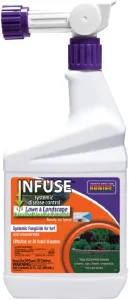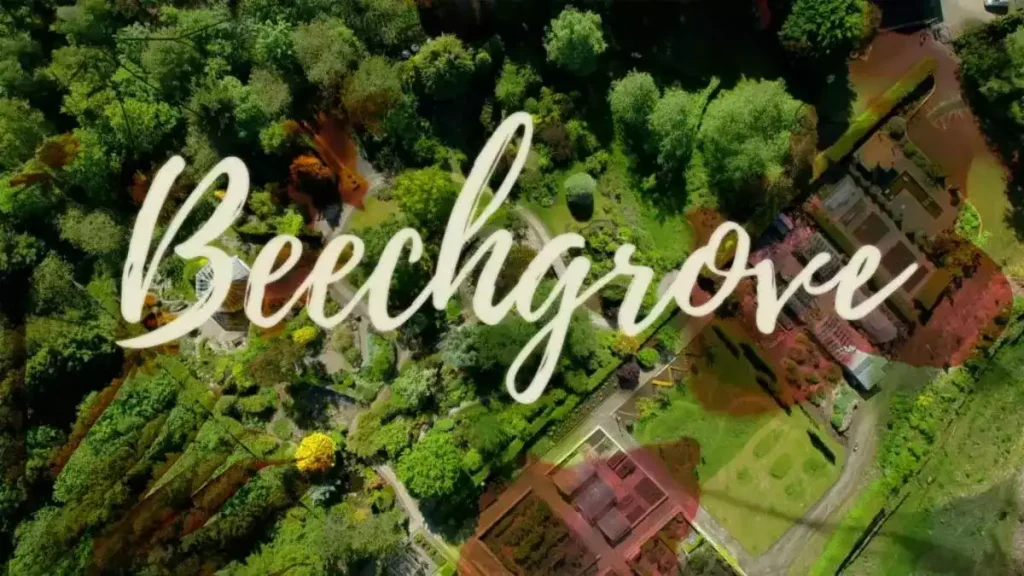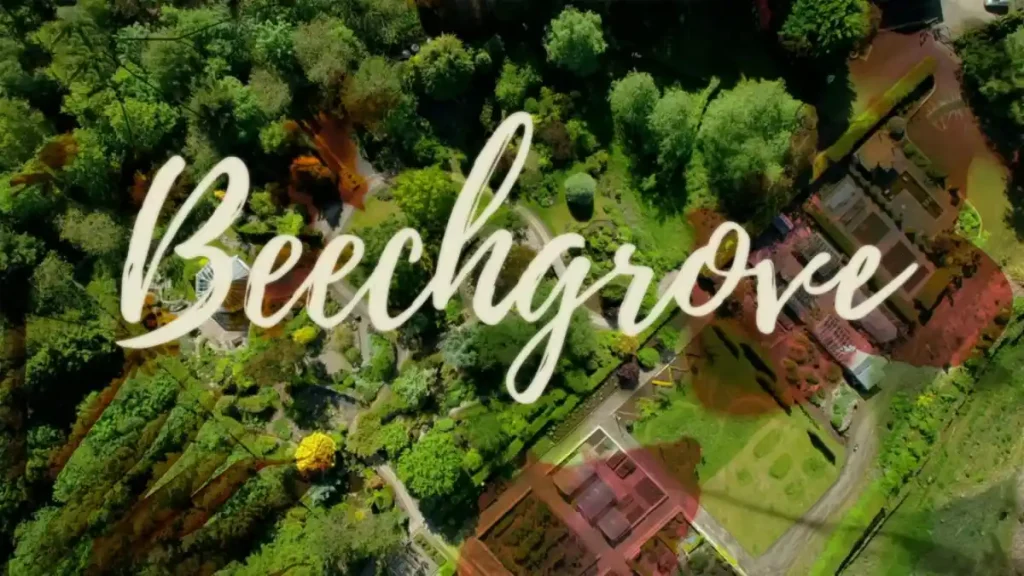The Beechgrove Garden 2023 episode 21 – Carole Baxter confidently steps into the spotlight, unveiling the latest installment of the revered “Back to Basics” series—a definitive guide that every gardening aficionado should have on their watchlist. This particular episode promises a deep and enlightening dive into the often-neglected world of plant adversaries, including the myriad of bugs, blights, and diseases that lurk in our gardens. But Carole’s approach is not one of mere identification. She paints a vivid, almost cinematic picture of the potential chaos and devastation these foes can unleash on our cherished green sanctuaries.


Infuse Lawn & Landscape Systemic Disease Control (32 FL. OZ)/946 ml
However, it’s not all doom and gloom. Carole, with her vast expertise, ensures that her viewers are not left feeling vulnerable.
She meticulously arms her audience with a wealth of knowledge, tactics, and actionable strategies. From prevention to active combat, she ensures that every gardener, whether novice or expert, is primed to tackle these botanical threats with confidence and finesse.
As the episode progresses, the lush garden backdrop becomes the stage for two special guests: Diana Yates and Calum Clunie. Diana, her voice tinged with unmistakable pride and passion, takes viewers on a captivating tour of her innovative ‘vertical garden’ creation nestled in the heart of Beechgrove. This isn’t just any garden design; it’s a masterclass in maximizing space without compromising on beauty. Every plant, every layer, stands as a testament to the harmony between aesthetics and practicality.
For many, the challenge of limited gardening space, be it in snug backyard gardens or high-rise apartment terraces, can be daunting. But Diana’s vertical garden serves as a shining beacon of inspiration. It’s a vivid demonstration that, with a touch of creativity and dedication, beauty and functionality can coexist and thrive, even in the most confined of spaces.
The Beechgrove Garden 2023 Episode 21: Bugs, Blights, and Other Garden Diseases
The popular BBC gardening program Beechgrove Garden returned for episode 21 of its 2023 season, providing helpful tips and inspiration for home gardeners. This episode focused on protecting plants from some of the most common garden pests and diseases.
Host Carole Baxter presented an informative “Back to Basics” segment all about identifying and treating various bugs, blights, and other issues that can damage garden plants. She covered potato blight, apple scab, and blackspot disease on roses—explaining what symptoms to look for, how these problems develop, and key ways to prevent and manage them.
Meanwhile, fellow hosts Diana Yates and Calum Clunie explored other gardening topics around the Beechgrove estate. Diana reviewed the progress in her small “vertical garden” area, demonstrating creative planting ideas for gardeners with limited space.
Learning to Spot and Stop Potato Blight
Potato blight, also called “tattie blight,” can quickly defoliate and destroy potato plants once it gets started. Carole explained that this fungal disease thrives during cool, wet, and humid weather. Dark brown lesions form on leaves, stems, and tubers. Entire plants collapse within days under severe infections.
The Hutton Criteria provides guidelines for predicting blight outbreaks. Carole noted that two consecutive days with temperatures above 10°C and relative humidity above 90% for over 6 hours are optimal blight-spreading conditions. Regularly checking potato foliage becomes critical during potential blight weather. At the first small spots, remove and destroy affected leaves immediately before the infection spreads.
For any plant with over 25% damaged tissue, Carole recommended cutting off all foliage at the base to stop the blight from reaching the tubers. While not a cure, this containment strategy can sometimes save the potato crop. Preventing blight in the first place involves practicing good crop rotation, planting resistant varieties like Orla and Sarpo, and earthing up plants to protect tubers.
Controlling Apple Scab Fungus
According to Carole, apple scab fungus thrives under the same rainy, humid conditions that encourage potato blight. Small, olive-colored spots appear first on leaves and fruit skin. Without treatment, these lesions enlarge, turning brown or black. They disfigure apples but remain shallow enough for safe eating after peeling.
Promptly removing and destroying infected leaves keeps damage localized. Resistant apple varieties like Discovery and Grenadier avoid the worst scab problems. Providing good air circulation through proper pruning creates an environment less hospitable to the disease. As with blight control, preventive autumn sanitation including quick removal of fallen leaves stops apple scab from overwintering and reinfecting trees the following spring.
Battling Blackspot Fungus on Roses
Among the most serious rose diseases, blackspot fungal infections create dark spots ringed with yellow on leaves. Entire leaves turn yellow then brown as blackspot spreads. Carole noted this fungus favors rainy conditions and vulnerable rose types like hybrid teas, floribundas, and climbers.
Along with immediately pruning off affected leaves and branches, growing blackspot-resistant rose varieties is key. Kordesia, for example, is a yellow floribunda rose with good disease resistance. Proper siting, care, and feeding also strengthen roses against infections. Good air circulation, well-drained soil, full sun, and avoiding excessive nitrogen fertilizer reduce blackspot’s foothold.
Other Key Garden Diseases
In addition to the fungal blights and blackspots, Carole touched on common bacterial and viral diseases that can damage gardens. Bacteria like Pseudomonas and Xanthomonas thrive in humid weather and create leaf spots, cankers, and dieback on roses, tomatoes, peppers, and other plants. Mosaic virus diseases stunt plant growth and mottling leaves. Aphid-transmitted rose rosette disease causes malformed flowers and stems. Careful inspection, hygiene, and propagation allow the containment of bacterial and viral pathogens.
Diana’s Small “Vertical Garden”
Co-host Diana Yates gave viewers a tour of her vertical garden section at Beechgrove, designed to maximize planting in a small 4×4 meter space. Vertical structures and containers leveraged vertical growing space for increased yields. Diana used colorful verbena, tall cosmos, climbing beans, and vining nasturtiums climbing on obelisks and trellises. She interplanted ornamentals like dahlias with edible crops in containers.
Though bunnies ate her lower-growing lettuces and strawberries, Diana’s vertical approaches kept other produce away from these garden pests. She advised leaving spent plants to stand for seed harvest, then following up with cool-weather crops like broccoli and greens. Protective covers or mesh can shield plants from late cabbage moths and butterflies. Diana’s segment provided many great tips for maximizing a small garden.
Key Steps for Improving Lawns
Beechgrove co-host Calum Clunie joined head gardener Scott Jackson to evaluate the estate’s lawn care needs. They observed how clover sprouting up signals low soil nitrogen. Regular mowing hadn’t met the lawn’s nutritional needs amid unpredictable weather patterns. Thatch buildup was also apparent in some areas.
Scott recommended overseeding thin patches as well as aerating, scarifying, and top-dressing the entire lawn this autumn. Well-timed fertilization with a phosphorus-potassium-rich blend will feed the lawn’s roots without spurring excess top growth before winter dormancy. Letting grass grow taller before final mowing allows it to store more energy. These steps will rejuvenate the lawn for a healthy spring green-up.
Reviewing Progress in the Walled Garden
Beechgrove’s George Anderson provided updates from his summertime garden projects. He highlighted rejuvenating a tired rock garden screen by amending soil, improving drainage, and planting hardy sedums and sempervivums. George also explained how pruning and training a rampant climbing rose prevents it from smothering nearby trees. In the vegetable garden, he demonstrated a novel method for curing, organizing, and hanging onions to store them for winter use.
Key Takeaways from Beechgrove’s Advice
This fun and informative episode provided many helpful insights home gardeners can apply to their own yards and gardens:
- Learn to recognize and treat common plant diseases like blights, fungi, and bacteria. Be vigilant when the weather favors their spread.
- Choose resistant varieties of roses, apples, and other plants susceptible to certain diseases.
- Practice smart garden sanitation and hygiene to limit pathogens.
- Consider vertical gardening techniques like trellises, containers, and obelisks to maximize yields in small spaces.
- Address lawn problems now to ensure a healthy spring revival. Aerate, overseed, fertilize, and adjust mowing practices this fall.
- Rejuvenate tired garden features like rock gardens, overgrown beds, and overworked soil with amendment and replanting.
With the right prevention and prompt treatment, gardeners can keep plants healthy amid whatever pest and disease threats come their way.
Frequently Asked Questions About Common Garden Diseases
What are some of the most common garden diseases?
Some of the most prevalent garden diseases include fungal and bacterial blights, powdery mildew, molds, rots, wilts, leaf spot diseases, rust, and mosaic viral diseases. Different plants are susceptible to different diseases, but proper care and hygiene can prevent many problems.
How can I prevent fungal blights in my vegetable garden?
Avoid excessive moisture and crowding, stake/trellis vines, practice crop rotation, pull diseased plants immediately, clean up crop debris, and improve garden drainage/airflow. Choose resistant varieties when available and follow blight prediction guidelines.
What causes black spot disease on roses?
The fungus Diplocarpon rosae causes blackspots, favored by wet conditions, susceptible varieties, and crowded planting. Choose resistant roses, improve air circulation via pruning/spacing, water at the base, and quickly remove diseased leaves/canes.
How do I know if my lawn has a disease?
Common lawn diseases cause visible symptoms like discoloration, lesions, rings, puffiness, wilting, and dieback. Rust fungus creates orange powder, while brown patch shows up as circular dead patches. Schedule regular lawn inspections to notice diseases early before they spread.
What is the best way to prevent diseases in my garden?
The best disease prevention starts with choosing resistant/tolerant varieties, proper planting sites, crop rotation, garden cleanliness, maintenance of soil health, early inspection for issues, isolation of diseased plants, and removal of contaminated plant debris.
Conclusion
This fun and informative episode of Beechgrove Garden offered many helpful tips and reminders for keeping gardens healthy and productive amid the threat of diseases. Paying attention to plant vulnerabilities, weather patterns conducive to disease spread, and early symptoms allows prompt treatment to avoid disasters. With knowledge and vigilance, gardeners can take a proactive stance and create gardens where plants thrive with minimal pest and disease problems.




